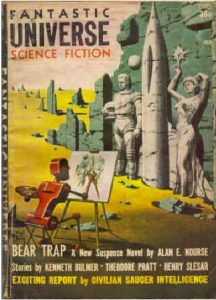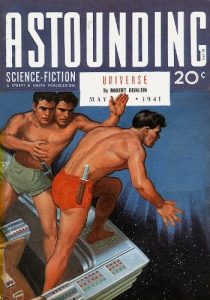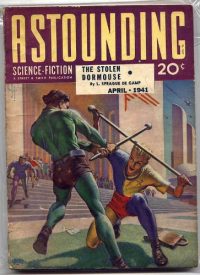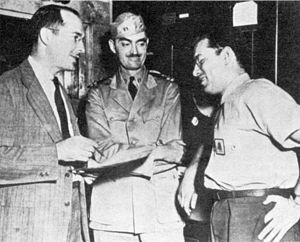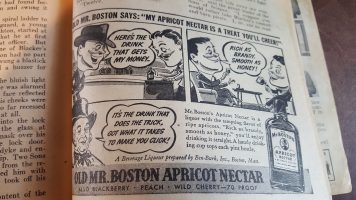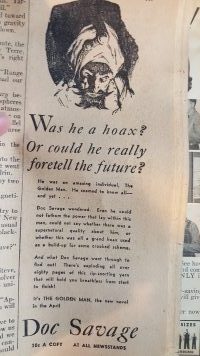Greetings all
It’s been a while since I did a magazine review, so I’ll explain what I’m doing. I have a goodly amount of Analogs, Amazings, Astoundings, and a bunch of other SF/F magazines from the 30s to the 70s. I’m going to read one a week and give you my review. I’ll be looking at everything, including the ads, because there’s lots of fun things to see in these. Also, I’ll be linking everything I can, usually from the fantastic Internet Speculative Fiction Database.
This week I’ll be reviewing the “Worlds of If” from October, 1971. This was an exciting issue to read for me because it included both a Stainless Steel Rat story and a Retief story. Not surprisingly, the theme for this issue is “insouciant.”
Table of Contents: http://www.isfdb.org/cgi-bin/pl.cgi?58836
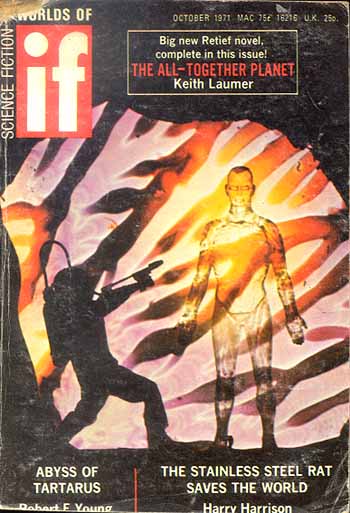
This isn’t my favorite cover art of all time, but it is such a great example of the powerful, evocative art that is on so many covers. It’s kinetic, which now that I think about it is probably the best way to describe the goal of these magazines.
The ads on the interior covers of these magazines are often delightful. This issue’s is no exception. It leads with the questions: “Can Freddie Fong Fine save the world? If so, should he?” OK, you got me to look. It’s an ad for Richard Lupoff’s Sacred Locomotive Files, which includes not only the titular locomotive, but also, among many things, a hyponuclear submarine (which sounds cool), Mavis Montreal the groupie, and “other denizens and features of the world of 1985.” I certainly wish Lupoff had accurately predicted 1985, because my junior year in high school was nowhere near that interesting.
The first section is Hue and Cry, the letters to the editor. The best letter was by a geology student taking issue with A. Bertram Chandler’s use of the word “extrusion” with relation to granite. Indeed, she “leaped up in horror!” upon seeing that usage. She concludes with a truly dire curse: “May the next koala bear Mr. Chandler meets eye him with reproachment.”
The first story is The Stainless Steel Rat Saves the World by Harry Harrison. The Stainless Steel Rat is a fantastic character so I was really looking forward to this story, especially since I hadn’t actually read this one before. In the story someone is going back in time to change the upstream to kill off the entire Special Corps. Slippery Jim is just the man to get sent back in time to return time to its proper course.
The Rat gets sent back to 1984 with the help of Professor Coypu’s Helix. Things happen in a rush, of course, and he is sent back in time with all the equipment that they can throw at him. Gotta love the toys the Rat’s toys.
He arrives in 1984 and quickly gets himself a criminal associate. They rob a bank, but the associate leaves the Rat in the lurch. The Rat steals a police car in order to escape. Eventually he ends up in the hands of the mastermind, and only by the aid of the special potion hidden in one of his teeth that turns him into a superman is he able to escape. He turns the tables and defeats the evil mastermind and thereby saves the world.
I expect the Rat to have a useful gadget for every occasion, even though more often than not it is first mentioned right when he needs that precise thing. For some reason though, this particular tool bothered me. Supermen, even temporary ones, don’t work as well for me as the gadgets.
That kicked me out of the story for a moment, and the joy of Stainless Steel Rat stories is that you put your seat belt on and get taken for a roller-coaster ride. This is probably my least favorite Rat story, which means I liked it but didn’t love it.
Side note. When I roam through the ISFDB or other pages as I do these reviews, I come across various interesting things here and there. I now know that “acciaio” is stainless steel in Italian. In Dutch? Well that’s “roestvrij staal.” I’m sure one of those will provide the answer for Final Jeopardy one of these days.
I’m a fan of the Stainless Steel Rat, but I’m a fanatic about Jame Retief, who stars in the next story. The All-Together Planet by Keith Laumer is a Retief story I’ve never read, which is a surprise, since I thought I had all the Retief books and collections.
Another uncovered tidbit: Laumer always pictured Retief as having black hair and looking something like Cary Grant. Hence, he didn’t like the covers from the 1980s Baen reprints where Retief is blond. In fact, those covers of him were based on Corbin Bernsen. Now I have this vision of Jame Retief playing third base for the Cleveland Indians in Major League.
Anyway, this is all that one wants from a Retief story. The Corps Diplomatique Terrestrienne has sent him and Magnan to a planet with an odd species, the Lumbagans, that evolves as separate body parts which gather together beginning with a group of ten. These parts can be anything, legs, arms, eyes, spleens, whatever, but the initial critical mass is ten parts. That’s a Singleton. Two of them get together and you have a Dubb. Two Dubbs can join together to become a Trip, and then two Trips can amalgamate and become the pinnacle of evolution, a Quad.
As usual, the Groaci are trying to gain control of the planet. Retief navigates with his usual wit and skill through the normal Groaci diplomatic corps, but finds one of their leaders, Ussh, to be unusually elusive.
Eventually Retief tracks Ussh down to discover he’s one of the largest Groaci he’s ever met before. Ussh is also more ambitious than most Groaci, which is saying something. He actually wants to rule the galaxy and his plan includes breeding Lumbagans to make a modular army of sorts.
As usual, Retief gathers allies among the locals, Gloot and Ignarp. At the end, in prison, he comes up with a desperate plan, one that leaves his allies in horror. Retief has figured out that Ussh is not a Groaci at all, but a super Lumbagan who is an amalgamation of two Quads who merely arranged his appearance to look like a Groaci. He tells Gloot and Ignarp that the only way to defeat Ussh is for them to combine as well, giving them equal powers to the mighty Ussh. They name themselves Lucael, which Retief agrees is “better than Michifer.”
Lucael and Retief head off to face Ussh and the Lumbagan emperor. In the end, it turns out that the emperor is essentially mindless and is completely controlled by Ussh. However, this taxes even the power of a super-Lumbagan, especially when faced with one who is just as powerful. In true Retief fashion, he manipulates the scene to expose the fraud, allowing Lucael to split Ussh back to his constituent Lumbagans.
At that poing Lucael assumes the throne and makes several proclamations, including telling all foreigners to stop meddling in Lumbagan affairs or “be shipped home in a box,” much to the horror of both the Groaci and CDT (except, of course, Retief). Then he declares all laws illegal, “including this one.” At the end, Lucael promises their emperor will return, should the need arise.
Then Lucael disappears to Ignarp and Gloot can separate back into themselves. But fear not for them, they take positions in the newly-created government-in-exile, “the only place for a government to be.”
No mere review can properly convey the sly subtleties that Laumer slides in. You may not be able to read this particular story, but I suggest you find a Retief story somewhere and remember the absurdity of bureaucracies.
The next story is To Kill a Venusian by Irwin Ross. This is the third and last story Ross ever published in a SF magazine. There’s a reason for this, and it’s not a pleasant one. Ross plagiarized To Kill a Venusian from Anthony Boucher’s story Nine-Finger Jack published in 1952 and no magazine ever published anything else by Ross.
The story basically involves a serial killer, who discovers his latest wife is actually a Venusian, who can’t be killed with any method known to humans. Ultimately, he discovers that human flesh is a deadly poison to them, and he escapes by killing the Venusian wife by cutting off his finger and putting it into their food. Gruesome and fun. Nice job by Boucher in 1952.
By the way, here’s an article by Robert Silverberg that discusses plagiarism in SF, including Ross’s. It’s at: http://www.asimovs.com/assets/1/6/Reflections_RobertHeinlein_OctNov14.pdf.
Anyway, next we move to One Moment in the Sand by Barry Weissman. In this we have a variety of people scrabbling about in a post-Apocalyptic world. These people are fantastically changed, though, including one who is a red dragon.
They find a cave and start exploring. The find a cave with a lot of oldtime equipment, including a large pillar. They start playing with it all. One presses a button causing lights to flash and sirens to wail. They keep pressing things and ultimately the large pillar ignites, burning them all and launching, for it’s an ICBM. It comes down on a farm halfway across the world.
All in all, not my favorite. It was less a story than a vehicle to say that nuclear weapons are bad. For message fiction to work, it has to be a good story, and this wasn’t.
Next we turn to After the End and Before the Beginning by William Rotsler. I will say that this magazine had some interesting authors, as Rotsler was also a writer, director, and actor in about two dozen porno movies as well as an illustrator in SF fanzines along with his SF writing.
This story is also message fiction in its own way, but far better written. It’s also set in a post-Apocalyptic world, one where the Earth has essentially been covered in buildings but the civilization has foundered. Dagger, the main character, is the leader of one of the many roving gangs.
Along the way, he finds a girl he wants to take so he chases her. Initially, he kidnaps her but eventually convinces her to come with him because one of his gang has books and knows how to read. He tells her of pirates and Robin Hood. In the end, he promises her he will read books to her. He’s not sure how he’ll do that, but he knows he will. The message is that reading will change your life in ways you never anticipate.
A solid story, with action and character growth. It’s not one that would win awards, but it’s worth reading.
Lester del Rey provides his list of reviews next in his Reading Room. He starts this with a discussion on the importance to SF readers and writers to read a wide variety of things, not just SF but fantasy, mystery, history, and everything else one can. The most interesting review in here was a collection called simply The Pulps edited by Tony Goodstone. This includes a bunch of pulp covers as well as fifty pulp stories, including a couple SF titles, some Lovecraft, The Shadow, Doc Savage, and a supernatural story from Tennessee Williams. This looks fun and I’ll probably get a copy one of these days.
The science article in this magazine is an essay by L. Sprague de Camp called Death Comes to the Megafauna. It’s a study of the possible reasons why megafauna disappeared. I would guess that in the half-century since he wrote this there have been many discoveries to answer and inform his questions, but I’m not knowledgeable enough in this field to be able to pick through this properly. These science essays provide a lens to see the process and growth of a discipline, and I suspect people in this field would really find fun connections. Not so for me, I’m afraid, though I did learn some places to look when I write a story about megafauna.
The last story in this issue is Abyss of Tartarus by Robert F. Young. This is one of his Spacewhale series, which are leviathans who can see in time and space and can be fitted as an FTL spaceship for humans.
The story centers around Starfinder, a man with blood on his hands, including the spacewhales, who he hunted to make ships for men. He had achieved some absolution by saving one whale from death, but now has new blood on his hands.
The spacewhales dive into the Sea of Time, which the Starfinder discovers is a passage as well to Tartarus. The Erinyes board the vessel to damn him for his guilt. The fight not only goes between him and the Furies, but also with the spacewhale, who resents the human’s attempts to master him. In the end, they become friends and allies.
This is one of those frustrating stories that I could really love, but the arc felt rushed. The conflict resolved itself too quickly, especially after the excellent setup including the Erinyes. If he’d have had time, I bet Young could have had Starfinder face each of the Furies in turn, dealing with each of their specialties, and at the same expanding on the transition from uneasy allies to friends, which felt forced and hurried.
This is not an uncommon problem in SF magazines, and of course many of these are expanded from shorts to novels and novelettes. I’m going to look for more from Young to see if he expanded on the story, because the idea of the spacewhales is really cool.
Lastly, we come to the SF Calendar, which is a list of upcoming SF conventions. If I ever create a time machine, I’m definitely going back to some early conventions.
Overall, this was a very good issue, but not a great one. The Retief story brought it close, but the other stories didn’t quite carry enough of the load to put it in the absolute top tier. Say, an 8 or even an 8.5.
Next Week’s Issue: http://www.isfdb.org/cgi-bin/pl.cgi?56754
Next week, I’ll be reviewing the Analog from July, 1962. The cover story is from John Brunner, and includes James H. Schmitz and Mack Reynolds. See you then.
If you have any comments or would like to request I keep my eyes open for a specific issue or month, feel free to comment here or send an email to me at: rob@robhowell.org.
If you want to see previous reviews, the Mag Review category is here: https://robhowell.org/blog/?cat=432.
Have a great day.
Rob Howell
Author of the Shijuren-series of novels
- Website: www.robhowell.org
- Patreon: https://www.patreon.com/rhodri2112
- Blog: www.robhowell.org/blog
- Shijuren Wiki: http://www.shijuren.org/World+
of+Shijuren+Home - MeWe: https://mewe.com/i/rob.howell1
- Facebook Author Page: https://www.facebook.com/robho
well.org/ - Twitter: https://twitter.com/Rhodri2112

